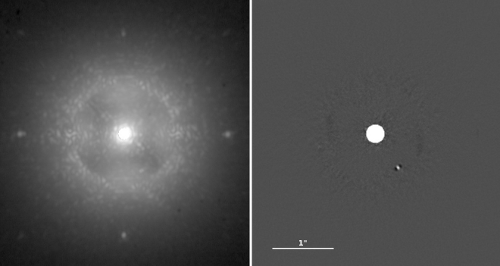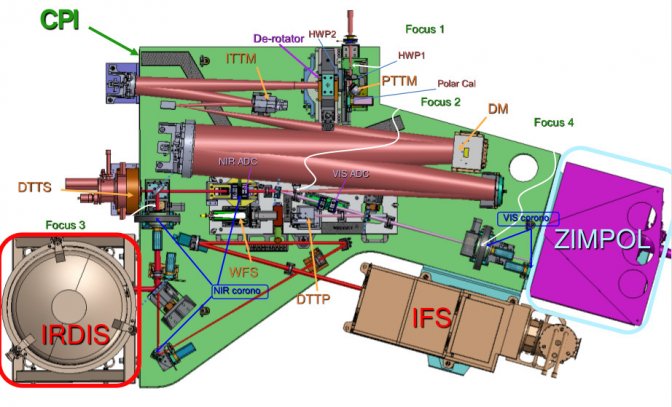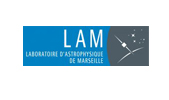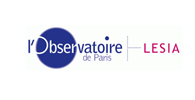Instrument - Technology
4 March 2014 ( maj : 25 November 2016 ), by
Combining technological and scientific challenges, SPHERE is one of the most innovant ground-based instrument built to date.
SPHERE is composed of four main sub-systems:
- SAXO : an extreme adatpive optics system aimed at compensating in real-time the degradation of the spatial resolution induced by the atmosphere,
- Stellar Coronography : A modul dedicated to the stellar flux suppression to reveal the exoplanetary photons,
- IRDIS : Spetral and polarimetric differential imager in near-infrared,
- IFS : Integral field spectrograph in near-infrared,
- ZIMPOL : Polarimetric differential imager in visible
SPHERE combines three high-contrast techniques :
- extreme adaptive optics (XAO)
- coronagraphy
- spectral, angular and polarimetric differential imaging
The first technique enables a real-time compensation for the the atmospheric turbulence. It requires a wavefront sensing system and a deformable mirror. This sevro-loop system will provide us with a correction of 85-95% in terms of Strehl ratio in near-infrared. The deformable mirror is composed of 41x41 actuators to correct the field of view over 1" in radius with a milli-second temporal sampling.
Coronography enables the stellar light partial suppression to reveal the exoplanetary photons. A focal plan mask is used in combination with a pupil stop. SPHERE includes various types of coronographs (amplitude, phase) with the challenge to attenuate the stellar light as close as possible from the star and for a large spectral range. SPHERE coronographs have been developed with these top-priorities. However, even a perfect coronograph is not able to completely suppress the stellar light as a on-negligible stellar light residual is not corrected by the adaptative optics system. A third technique is then used.
Differential imaging consists in taking advantage of the spectral differences between stars and planets to detect and characterize the young exoplanets. Giant planets atmosphere for instance are composed of chemical elements (water, methane, amonia, carbon monoxide and/or dioxide), not present in the stellar atmospheres. These differences can be optimally used to suppress part of the stellar light and to reveal broad molecular absorptions in the planet’s spectrum. Two SPHERE instruments (IRDIS and IFS) use that technique and the third instrument ZIMPOL use the polarimetric information. In addition, angular differential imaging can be added using the fact that field and pupil are rotating at the Nasmyth focus of an alt-az Telescope. This last technique enables to discriminate fixed instrumental aberrations from astrophysical sources like exoplanets.

The three SPHERE scientific instruments are detailed below:
- IRDIS Infra-Red Dual-beam Imager and Spectrograph: The Infra-Red Dual-beam Imaging and Spectroscopy (IRDIS) sub system constitutes the main science module of SPHERE. The main specifications for IRDIS include a spectral range from 950 to 2320 nm and an image scale of 12.25 mas per pixel consistent with Nyquist sampling at 950 nm. A FOV greater than 11" diameter is required for both direct and dual imaging, leaving a slight margin for system optimization when using two "quadrants" of a 2kx2k detector. The main mode of IRDIS is the dual band imaging (DBI), providing images in two neighboring spectral channels with minimized (<10nm rms) differential aberrations. Ten different filter couples are defined corresponding to different spectral features in modeled exoplanet spectra. In the direct imaging mode, 12 broad, medium and narrow-band filters are defined. In addition to direct and dual imaging, long-slit spectroscopy (LS) at resolving powers of 50 and 500 is provided, as well as a dual polarimetric imaging mode (DPI). A pupil-imaging mode for system diagnosis is also implemented. Dual imaging separation is done using a beam-splitter combined with a mirror, producing two beams in parallel. Each beam has its own camera doublet and band-limiting filter. The main challenge is to achieve the required 10nm differential aberrations requirement, but an error budget based on high-quality classical polishing technology is found to satisfy the requirement. This option has been favored over the alternative Wollaston-based option used for example in the NACO SDI camera because it eliminates spectral blurring problems, which would limit the useful FOV, and allows the use of high-quality materials with high homogeneity.
- IFS Infra-red Integral Field Spectrograph: While an integral field spectrograph (IFS) for planet imaging is conceptually challenging, it is widely recognized as a potentially extremely useful science module for a planet searching instrument. The reasons for this are two-fold: Firstly the IFS can be build with virtually zero differential aberrations, and secondly the multiple spectral channels allow for better correction of speckle chromaticity and even data analysis strategies that do not rely on the presence of a-priori assumed features in the planet’s spectrum. For SPHERE we are pursuing a micro-lens based IFS concept BIGRE, that is an evolution of the classical TIGER concept modified for the case of high-contrast diffraction limited observations. The required 5-σ detectivity at 0.5" is 1e-7 with a goal of 1e-8 with respect to the un-occulted PSF peak, and the spectral range of the IFS is limited to the Y-H bands (0.95-1.7µm), allowing the use of a single detection channel and parallel operation of IRDIS (in H-band) and IFS (in J-band). A resolving power per pixel of 30 is maintained, with a minimum FOV of 1.35" square and a strong goal of 3" square. Nyquist-limited spatial sampling at 0.95µm is imposed as for IRDIS. Optimized commonality between IFS and IRDIS in terms of detector and associated equipment is seen as an important system goal. The same 2kx2k detector format is therefore adopted, and it is highly likely that the long-wavelength cut off defined for IRDIS will also be acceptable for IFS.
- ZIMPOL Visible Differential Imager: The Zurich Imaging Polarimeter (ZIMPOL) subsystem is a high-precision imaging polarimeter working in the visual range, covering at least from 600 to 900 nm. The instrument principle is based on fast modulation using a ferro-electric retarder, and demodulation of the polarization signal using a modified CCD array. Key advantages of this technique are the simultaneous detection of two perpendicular polarizations (the modulation is faster than seeing variations), and the recording of both images on the same pixel. Thanks to this approach, a polarimetric precision of 1e-5 or even better should be achieved. The CCD will cover a Nyquist sampled field of 3" x 3" square and it is foreseen that the FOV can be moved around the bright star so that a field with a radius of 4" can be covered. In addition to polarimetric imaging, ZIMPOL provides the possibility for high resolution imaging in the visual range using a set of broad and narrow band filters. This capacity will be unique in the post-HST era.
Since May 2014, SPHERE operates at the VLT/UT3 for the ESO community.
















